Displaying items by tag: medical
The Buzz from the Medical Tracks
We love hearing from you in the pregnancy help medical community.
Here's a sampling of what attendees said about the 2014 Heartbeat International Conference in Charleston, South Carolina. The Conference featured 78 workshops, including six each in the Medical Matters and Ultrasound Advancement tracks, in addition to two medically focused in-depth all-day workshop sessions and a special keynote from John Bruchalski, M.D., founder of Tepeyac Family Center & Divine Mercy Center.
1. "I feel much more confident after these workshops and webinars. Thank you!"
Jo-Ellen O'Keefe, Pregnancy Help and Information Center (Ectopic Pregnancy, Audrey Stout RDMS)
2. "Very interesting and groundbreaking information – this will change things!"
Reagan Nielson, Vitae Foundation (Update on Abortion Pill Reversal, Dr. Delgado)
3. "Dr. Delgado's presentation was so very exciting! It was interest peaking, informative and empowering. I'm grateful for his work and research regarding the APR. (Abortion Pill Reversal)"
Jamie Koser, Heartline Pregnancy Center (Update on Abortion Pill Reversal, Dr. Delgado)
4. "Very creative teaching! Lots of light bulbs went off!"
Cheryl Didrekson, Kimberly Home, Inc. (Flipping Uterus, Roxanne Ertel RDMS)
5. Amazing presentation! I have been scanning for 12 years and finally understood the anatomy of the uterus on U/S! Thank you!"
Jennifer Snowden, New Beginnings Women's Center (Flipping Uterus, Roxanne Ertel RDMS)
6. "Super excellent."
Katherine Niemiec, Family Life Services Clinic and Pregnancy Center (Flipping Uterus, Roxanne Ertel RDMS)
7. "Thank you! This was the most enlightening session of the week and worth the entire trip to learn these nuggets."
Patti White, New Beginnings (Flipping Uterus, Roxanne Ertel RDMS)
When am I Due? Why Should I be Concerned?
Healthy Pregnancy/Healthy Baby Series: Part 1
By Helen Risse RN MSN
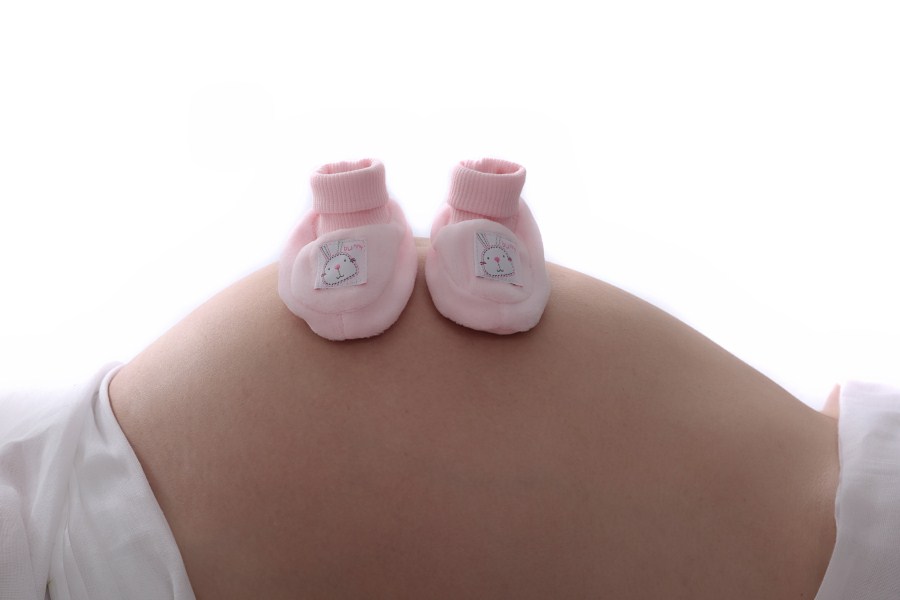 If you work with pregnant women, you have a great opportunity to improve birth outcomes. When a new client visits your pregnancy help organization, this may be the only contact you have with her.
If you work with pregnant women, you have a great opportunity to improve birth outcomes. When a new client visits your pregnancy help organization, this may be the only contact you have with her.
What should she be sure to know before she leaves you? Does she know her due date? Will you be telling her based on the first day of her last menstrual period?
It is important to define due date and term pregnancy. Remind your new mother that her due date is really a due time that looks at two weeks before to two weeks after that date as being "term". Many people still think of pregnancy in terms of nine months. Explain that pregnancy is defined as 40 weeks or 10 lunar months.
At the end of 2013, the American College of Obstetrics and Gynecology (ACOG) redefined the meaning of "term".
- Early term: Between 37 weeks, 0 days and 38 weeks, 6 days.
- Full term: Between 39 weeks, 0 days and 40 weeks, 6 days.
- Later term: Between 41 weeks, 0 days and 41 weeks, 6 days.
- Post term: Between 42 weeks, 0 days and beyond.
Research has noted that the brain of a baby at 35 weeks, 0 days grows in size by two-thirds in the following four weeks.
Research has noted that although the weight of a baby may look normal, babies born before 39 weeks are sleepier babies. These babies do not latch and suckle as well as babies born at 39 weeks 0 days. They have more problems with higher bilirubin levels. These concerns can lead to serious consequences. The choice of an elective delivery date must factor in these findings.
Women should also be taught the signs of preterm labor. Teach women about contractions. Explain what they may feel and describe those symptoms that should put them on alert.
Describe contractions as feeling like:
- Menstrual cramps
- Low, dull backache
- Pelvic pressure—feeling that the baby is pushing down
- Heavy feeling in your pelvis (pelvic congestion)
- Stomach cramps—with or without diarrhea
- The abdomen may tighten or get firm then relax or soften
Describe vaginal discharge or bleeding:
- An increase or change in your normal vaginal discharge
- Red, brown or pink discharge or spotting
Describe water breaks:
- Gush of fluid from vagina
- Slow trickle of fluid from vagina-(panties feel wet and you don't know why)
General feeling that something is not right.
What should she do if she thinks she may be having preterm labor? Below are some guidelines you may discuss with your Medical Director to develop a policy/procedure for your center.
- Empty bladder
- Drink 1-2 glasses of water or juice (no caffeine, sugar, or sports drinks)
- Lie down on your side and time the contractions from the beginning of one to the beginning of the next. Write down when the contractions start.
If the contractions are coming more than every 15 minutes or 4-6 in an hour, call your doctor.
It is important to stay well hydrated. Dehydration can often cause a woman to experience contractions.
Women should know the risks that increase concerns for preterm labor. Women who are at greatest risk for preterm labor are those who have had a previous preterm birth, as well as those who are pregnant with multiples, and those with certain abnormalities of their uterus or cervix.
Other risk factors include smoking, drinking alcohol, using illegal drugs, domestic violence, including physical, sexual or emotional abuse, or lack of support.
Additional risks factors related to her health include infections, including urinary tract infections, sexually transmitted infections, diabetes, high blood pressure, second trimester bleeding from the vagina, being underweight before pregnancy, obesity, and a short time period between pregnancies.
When asked if there is anything that can be done to prevent preterm labor, tell a woman to:
- See her doctor early and regularly during pregnancy,
- Eat nutritious meals and snacks,
- Drink at least 8 glasses of water, juice or milk every day, and
- Avoid cigarettes, alcohol, drugs and medications not prescribed by her doctor.
If you have one visit from a pregnant woman and pass on this information, you may contribute to an improved outcome. Every extra day her baby is in a healthy intrauterine environment is positive for the development of her baby, which in turn can be a big help to a new mother.
References
Spong CY. Defining "Term" Pregnancy: Recommendations From the Defining "Term" Pregnancy Workgroup. JAMA. 2013;309(23):2445-2446. doi:10.1001/jama.2013.62
ACOG Clinical Guidelines: Definition of term pregnancy. Committee Opinion No. 579. American College of Obstetricians and Gynecologists. Obstet Gynecol 2013;122:1139–40.35
Go the Full 40 Campaign tool Kit :http://www.health4mom.org/pregnancy/healthy_pregnancyo
The last weeks of pregnancy count: July 5th, 2012l Kit: http://newsmomsneed.marchofdimes.com/?tag=brain-development
At the Heart of What it Takes to go Mobile
by Michele Chadwick, Director of Operations, ICU Mobile
 Heartbeat's Betty McDowell gave an encouraging message in her presentation at the 2014 Heartbeat International Conference, which came down to a single phrase: I see you. The God of the universe acknowledges and recognizes you. You are valid.
Heartbeat's Betty McDowell gave an encouraging message in her presentation at the 2014 Heartbeat International Conference, which came down to a single phrase: I see you. The God of the universe acknowledges and recognizes you. You are valid.
At ICU Mobile, our name and mobile ultrasound ministry (ICU, think "I See You") was born out of a call to proactively reach out to help mothers see their babies in the womb, identifying that every life is valid—sometimes for the first time in a mother's heart.
Revealing and affirming life is at the heart of all our ministries, serving a vital, essential role in life-affirming work. When a pregnancy center provides medical ultrasound imaging, its representatives affirm that the act of visibly revealing life is essential to the ability to fully inform a pregnant mother of the life she carries.
Going mobile medically brings this vital life-imaging service to mothers outside of the center. At ICU Mobile, we believe that at the heart of an accomplished mobile medical clinic, as in the pregnancy center, is a commitment to offer services with faith, wisdom, and experience as our guide. We are committed to standing strongly on the strategic operating principle of extending the reach of our services for women into the –community—in the community of others.
A mobile medical clinic, when operating well, is a tool with the capability of joining a community together under the umbrella of life, drawing pregnancy resource centers together with the church and other community and organizational resources, in support of each other in the service of women.
Key factors that help encourage this united front include neutral branding, a process to provide a full continuum of care for the client, operating from each other's strengths through shared service models, and encouraging good stewardship through shared resources.
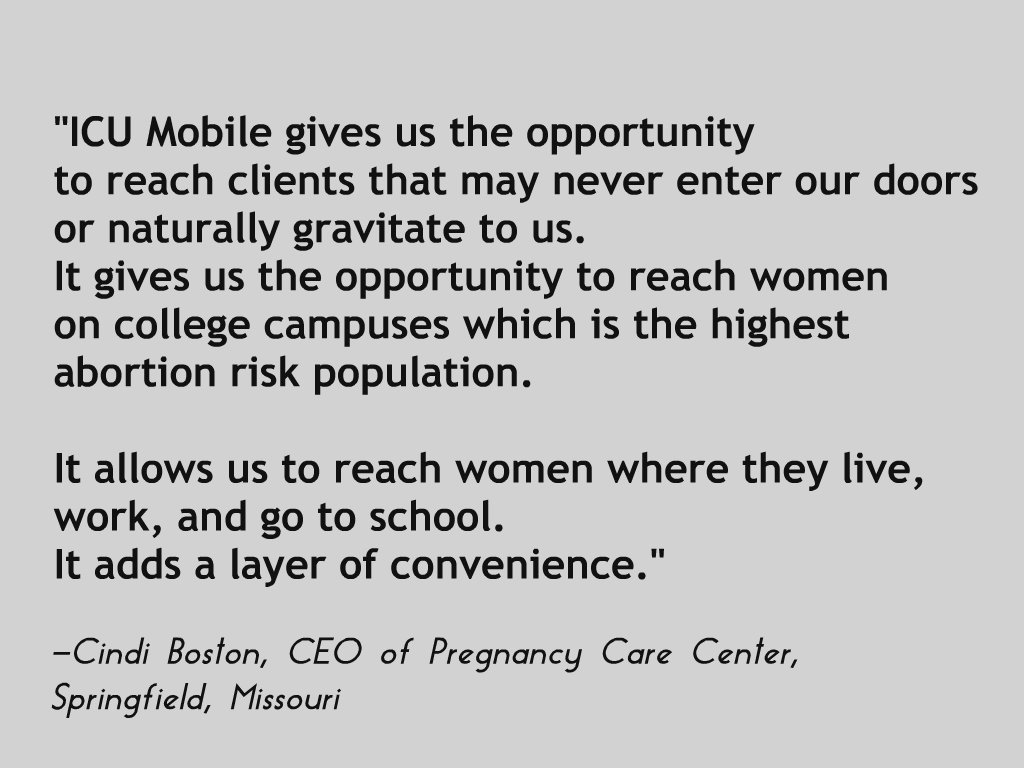 Pregnancy help expert Kirk Walden, in his book, "The Wall" (and who also presented at the Heartbeat Conference!) makes the case for uniting the community to serve women. He asks the question, "What happens if we're the first choice?" The "we" in this question is key. The "we" is all of us working together to be a mother's first choice. A mobile medical clinic can be the "vehicle" (no pun intended) for building this unity.
Pregnancy help expert Kirk Walden, in his book, "The Wall" (and who also presented at the Heartbeat Conference!) makes the case for uniting the community to serve women. He asks the question, "What happens if we're the first choice?" The "we" in this question is key. The "we" is all of us working together to be a mother's first choice. A mobile medical clinic can be the "vehicle" (no pun intended) for building this unity.
Mobile operations in joining others together can become one of the most effective ways to reach abortion-minded women. Mobile services provide an effective way to expand your reach without having to build a satellite office, expand internally, or require more space, and it allows a center the flexibility to move to locations to adjust to demographic changes and population shifts.
Further, going mobile avoids the issue of no-show appointments at your center, as well as helping to balance the number of clients seeking social support services and those seeking medical services. Going mobile alleviates the expense of renovation or expansion of services in your center, while providing opportunities to build network supports with other pregnancy help organizations in the community surrounding the center.
Each of these considerations factor into the thought process of going mobile in a community.
When considering the possibility of adding a mobile medical clinic, it is first important—as with adding any medical service—to recognize the seriousness of the endeavor and requires the highest level of commitment to a professional quality medical experience for the client, as it is visible and the first contact with a mother.
Equally important for an organization to note is that going mobile is a unique approach that influences how a center operates, affecting the procedural processes that are needed to accommodate a moving center. A board, leaders, staff, and the connected community must pray and seek wisdom and recognition of the call to serve in this mission capacity.
We recommend you seek others who already operate a mobile medical clinic to learn about effective methods of operation, strategies that work, and the significance of working together in community to serve. It is God who builds these mobile communities, so it will be God who lays the possibility and provides the opportunity for success.
As Kirk Walden asked at the Heartbeat Conference, "What can we do to join hands?" Mobile done in community with others will join hands, and as we are blessed to say at ICU Mobile, it joins hands for little feet.
Here are some practical questions and steps toward adding mobile services:
- Do you have a need to reach women in multiple locations who would benefit from the ability to change locations daily?
- Is your board and staff ready to take a logistically challenging step that would involve a comprehensive team effort?
- Contact ICU mobile and ask questions that would be important for you to consider when incorporating a new program.
- Once the board has the buy-in, meet with top donors to survey their interest in the project.
- Investigate friends and "influencers" on local college campuses to assess their interest.
Healthcare Worker
Serving as a nurse or other medical professional in a pregnancy help medical clinic (PHMC) can be of great benefit to clients and your organization. Physicians can serve as medical directors, which allows organizations to offer medical support such as ultrasound, STI/STD testing, prenatal care, and more. Nurses and sonographers, with the appropriate training, can provide ultrasound scans, pregnancy tests, and more. Even outside individual medical clinics and healthcare providers can join the Abortion Pill Rescue Network to help women who are hoping to save their children after starting a chemical abortion as prescribing providers or hotline consultants.
Heartbeat International has a fantastic array of courses available online through the Heartbeat Academy just for nurses in need of CEUs as well. Here is a simple way to gain additional skills and knowledge valuable to your position and ministry in the pregnancy help medical clinic while obtaining the Contact Hours you need to keep your license active.
Opportunities for training or supporting the pregnancy help movement for healthcare workers:
- Join the Abortion Pill Rescue Network
- Medical Matters (monthly eNewsletter free to affiliates)
- Archives (affiliates only)
- Medical Essentials Manual
- Online CEU Opportunities
- LOVE Approach Ultrasound Clinical (LAUC) Training
- Online Medical Training
- Abortion Pill Reversal Training
Want to Start a Pregnancy Help Ministry?
Starting a pregnancy help ministry is a big undertaking, and Heartbeat International helps you do it with confidence. We are deeply committed to supporting new ministries and expanding existing ones. Whether you are launching a brand-new pregnancy help organization or opening a satellite office to reach more women in your community, we offer tailored support to help you take those steps wisely. From strategic planning and operational guidance to team training and ongoing mentorship, our wide range of valuable—and often free—resources help you grow with confidence.
Whether you're in the earliest stages of planning, preparing to open your doors, or extending your reach through a satellite location, Heartbeat is here to walk with you every step of the way. Just email our Ministry Services department at This email address is being protected from spambots. You need JavaScript enabled to view it., and a specialist will connect with you.
Whichever ministry you decide upon, we recommend looking at some key resources to get you started on the right foot.
Recommended Resources for Start-Ups:
- Built By Design (Manual and/or Online Course)
- A Vision for Your Organization
- The LOVE Approach Manual
Click any of the below to start with the information you need.
 |
 |
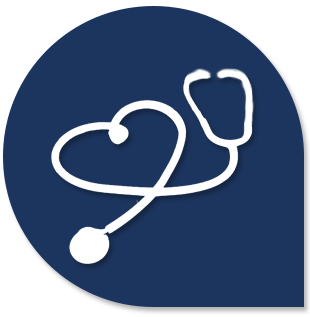 |
 |
 |
| Pregnancy Center | Maternity Home | Pregnancy Help Medical Clinic |
Abortion Recovery |
Long-Term Care |
Answering the call to reach, rescue, and renew men, women, and children—even entire communities—from the violence of abortion requires a team effort, with every life-saver pulling on the same rope.
Click one of the below to learn more about your unique calling... and what you can do to become best equipped on the front lines of the Pregnancy Help Movement.
 |
 |
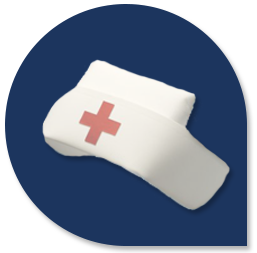 |
 |
 |
| Executive Director | Development Director | Healthcare Worker | Board Member | Volunteer |
Affiliate with Heartbeat International
As the world’s largest network of life-affirming organizations, we provide training, tools, mentoring, and a supportive community so you don’t have to do it alone. Affiliation gives your center credibility, protection, and resources—so you can focus on what matters most: serving women and saving lives. Click here to learn more about the 15+ benefits of affiliating with us!
Experts to Help! Pro-Life Maternal-Fetal Medicine Docs
Two important resources for your center and medical director
 |
by Susan Dammann RN, Medical Specialist
Dedicated to the care and preservation of both mother and fetus in every pregnancy, Pro-Life Maternal Fetal Medicine (MFM) is an association of pro-life doctors of like mind to AAPLOG (American Association of Pro-Life Obstetricians and Gynecologists).
This unique organization represents a contingent of life-minded Maternal Fetal Medicine (MFM) practitioners. (MFM is a subspecialty of Obstetrics and Gynecology dealing with all matters that can affect the health of a mother or fetus from before conception to the postpartum period.)
Members of Pro-Life MFM are also affiliated with the Society for Maternal-Fetal Medicine, a special interest group of the American College of Obstetrics and Gynecology who have received additional training and performed research in the care and management of pregnant women and fetuses.
The Role of Pro-Life MFM Practitioners
MFM professionals are specialists in high-risk pregnancy situations, and hold a uniquely expert place in relation to rank-and-file OB/GYN physicians or oncologists. MFM specialists are involved in guiding the management of medical and surgical complications a mother may encounter during pregnancy.
MFM specialists also provide diagnosis and management of medical and surgical conditions for the fetus. Care may include in utero treatment, modification of delivery timing or mode, and facilitation and coordination of care for the infant after delivery.
When a client presents in your center with a negative maternal or fetal diagnosis, there are alternatives to help ensure the survival of both mother and baby. For example, many women with a breast cancer diagnosis have carried their pregnancies to term and done better than women who abort.
Are you looking for a pro-life Maternal-Fetal Medicine specialist in your area? Visit Pro-Life MFM’s physician directory.
Hear from a Pro-Life MFM Expert
Dr. Murphy Goodwin, a well-known pro-life maternal fetal medicine specialist, wrote an excellent article called Medicalizing Abortion Decisions. Dr. Goodwin, whose obstetric practice in the Los Angeles area has been the largest in the United States for most of the last 15 years, serves many of the high-risk deliveries in the area.
While describing five cases of successful delivery where a mother had abortion recommended to her, Dr. Goodwin states that because of the dangerous combination of an ambivalent attitude toward the developing human in the medical community and fear of liability issues (owing to the unbalanced legal burden of informed consent and “wrongful birth”), physicians are often not providing readily available information that could affect their patients’ judgment regarding abortion when that mother has a major medical problem in pregnancy or any medical problem.
To suggest or recommend that abortion is the safest route carries no such responsibility, as there is no set legal precedent for a physician’s liability in a case where abortion was recommended on supposed medical grounds—even if that recommendation was subsequently found to be baseless or misrepresented.
Tragically, as Dr. Goodwin points out, “There is no counterweight to ‘wrongful birth.’ There is no ‘wrongful abortion.’
These are two helpful resources you’ll want to keep handy and make available to your medical director!
An Informed Look: A New Tool for Sharing the Truth
by Laura Strietmann, Associate Director, Pregnancy Center East, Cincinnati, Ohio

When I began serving clients in crisis at Pregnancy Center East in Cincinnati, Ohio over 7 years ago, I noticed that besides time, love, and an ultrasound, there was another powerful tool in assisting a woman in the choice of life for her unborn baby.
This was an outdated grainy VHS tape, entitled Abortion Techniques. Non-graphic in content, but real and compassionate, each time this tape was viewed by a client considering abortion, she left with a different mindset. The client usually moved from being abortion-vulnerable to choosing life for her baby.
Carol Everett, a former abortion clinic owner and operator, turned pro-life warrior, had filmed Abortion Techniques in 1993. It was a 25-minute video showing abortion through illustrations, actual tools, and Carol’s personal testimony. Many centers throughout the country use this video in teaching pregnant women the realities of abortion. Today, abortion has been made to seem as if it is equivalent to having a mole removed, as a “necessary” aspect of healthcare. Abortion Techniques showed how far these perceptions are from reality. One day several years ago, while working at PCE, our copy of the video broke. After searching for an updated replacement for this worn tape, I discovered that the industry lacked a current video with the most recent abortion methods sensitively presented in such an effective manner.
I decided to contact Carol Everett, now very busy as an internationally known pro-life author, speaker, and lobbyist for the state of Texas. Had she thought of making a more updated version of the video? Did she realize the number of babies’ lives saved by this tape? Would she see it was time to make a new film? Several months of persistent emails, Facebook inbox messages, and finally a phone conversation before Carol conditionally agreed to the project.
Having never met in person, only through internet and phone lines, Carol promised that if I could secure funding for the project, she would journey to PCE and make a new video. She would generously assign PCE the rights to the video as a means for fundraising. Through the generosity of the Ruth J. and Robert A. Conway Foundation, PCE was able to secure the funds to film the new version. This was not the answer I thought I would receive in my initial inquiries, but it was an incredible opportunity to affect the lives of the babies at PCE and now throughout the country.
Carol traveled to Cincinnati and Greg Schlueter, a Catholic moviemaker, and staff member for the Diocese of Toledo, OH filmed the video. On the afternoon of February 15, 2013 just as filming was wrapping up at PCE our doorbell rang. With a CLOSED sign on the door, two women still rang our bell desperate for help. As I opened the door and they noticed all of the filming equipment, the client begged for assistance. Stepping inside the Center, the client shared she was already well into her second trimester, but had finally just told her sister, who then found the Center and brought her for help. The situation was sensitive and the expecting mom was also post abortive.
As the young pregnant client and her sister described the crisis, Carol rounded the corner and heard the story. Right there in the lobby of PCE Carol listened to this young client and through a beautiful conversation offered so much understanding and hope. Carol counseled the client with sincerity and love. This client stayed in PCE’s care throughout her pregnancy and a perfect baby was delivered this summer. Mom is overjoyed with how everything has worked out. This was the first miracle of life from the updated video being brought to reality.
An Informed Look at Abortion Techniques is the new 14-minute modern life-saving tool. Using modern colors and graphics Mertz Design Studios completed this version to also include information on Plan B as well as RU-486 abortions. The initial launch of the video took place in April 2013 at the Heartbeat International Conference, selling over 100 copies to centers as far away as Alaska, Africa, Austria, and Germany.
After viewing the video in Dallas at the Conference, Janet Morana, Executive Director of Priests for Life, shared, “Every pregnancy center should be showing this movie to clients.” Reviews from center directors throughout the country are calling it “powerful,” the “best tool next to an ultrasound in reaching hearts and minds in the decision for life.”
On the day I write this article one absolutely abortion determined mom sat in PCE with a volunteer and viewed An Informed Look. The decision for life was made then and there while watching the video, even before the ultrasound. The client was astounded by the reality of abortion procedures. What happens to her body as well as the unborn baby’s was shocking to say the least. Even in a non-graphic manner, seeing how an abortion is performed is devastating enough. When making the biggest decision of her life a woman deserves to have complete information. Carol’s testimony is riveting.
Hearing the sorrow of a post-abortive women provides another enormous window to the reality of abortion. Viewing this film allows a woman, in the words of Carol “To make her decision fully informed.”
We hope to get this tool in the hands of thousands, including pregnancy resource centers, high school educators, and politicians. We will be distributing the video at future Catholic and pro-life conferences. Please visit us in Washington, D.C. during The March for Life convention. The video will continue to be sold through www.HeritageHouse.com, as well as directly through the Center, at 513-321-3100.
If you would like to connect with Laura about presenting the video at any future appropriate meetings or conferences please contact her This email address is being protected from spambots. You need JavaScript enabled to view it. or 513-321-3100.
Genetic Screening: The Brave New World?
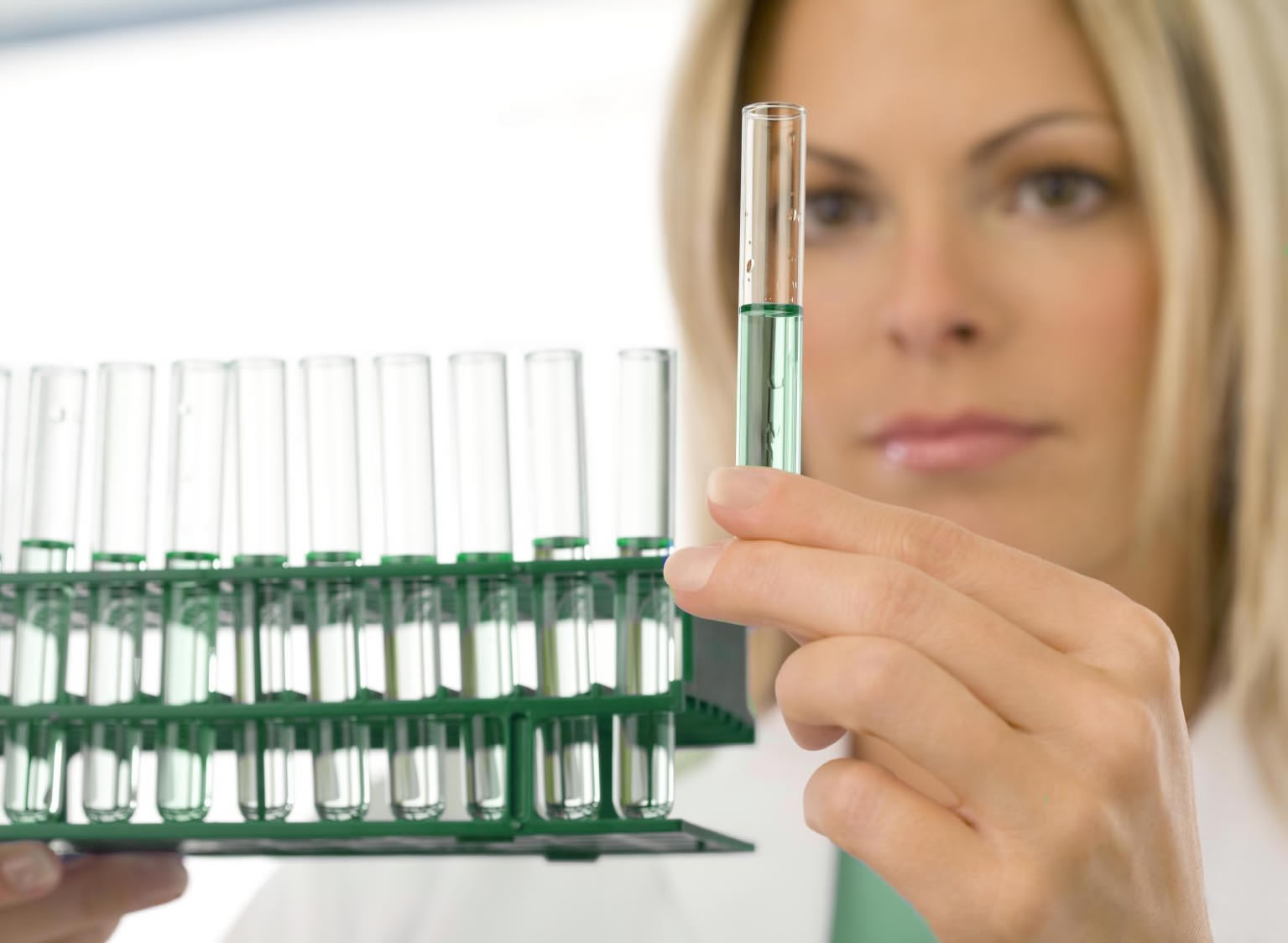 |
by Susan Dammann RN LAS, Medical Specialist
Recent advances in prenatal testing have afforded physicians and parents the opportunity to screen for abnormalities with a greater degree of accuracy, while identifying a broader range of disorders than ever before.
With this additional knowledge come both the opportunities to seek further testing and to better prepare for the birth of a child with a possible birth defect. Tragically, the increased prevalence of these tests does come with a deadly downside, and has already resulted in a higher number of children who are aborted because of a possible birth defect.
Technology today is taking us into even deeper uncharted waters, presenting greater challenges and opportunities as we consult with clients in the pregnancy center setting. Let’s take a look at some of what is currently available as well as what is on the horizon.
The Quad Marker Screen
Between 15 and 20 weeks of pregnancy, it is common practice for a pregnant woman to be offered the Quad Marker Screen test, as it can only be performed within this certain window of time. The test is optional, and due to uncertainties surrounding the test results, a woman may opt out of the test.
The Quad Marker Screen is a blood test that screens substances in the mother’s blood for problems in the development of the fetus’s brain and spinal cord, called “open neural tube defects”, as well as genetic disorders such as Down syndrome. The Quad Marker Screen can predict approximately 75-80% of open neural tube defects and approximately 75% of Down syndrome cases in women under 35 years old, and over 80% in women age 35 years and older.
The Quad Marker Screen does not diagnose, but rather, predicts the likelihood of a certain problem occurring, determining if a woman is at higher or lower risk of carrying a baby with a birth defect. The test involves no risk to the baby, as a blood sample is taken only from the mother.
Four substances (hence “Quad” Marker Screening) normally found in the baby’s blood, brain, spinal fluid and amniotic fluid are tested:
- Alpha-fetoprotein (AFP): a protein produced by the baby’s liver
- Human Chorionic Gonadotropin (hCG): a hormone produced by the placenta
- Inhibin-A: a hormone produced by the placenta
- Unconjugated Estriol (UE): a protein produced in the placenta and in the baby’s liver
The normal amounts of these substances in the mother’s bloodstream change during pregnancy. High AFP levels may indicate an open neural tube defect in the baby, or could indicate that the fetus is older than was originally thought. The numbers could also indicate that the woman is having twins.
An increased risk of a baby having Down syndrome is indicated by higher than normal levels of hCG and Inhibin-A, and lower levels of the hormone estriol.
Can normal test results guarantee a healthy baby? No, a normal result is not a guarantee, but it is a strong indication of health, achieving an accuracy rate of over 98 percent, according to WebMD:
Out of 1,000 pregnant women, approximately 50 will have quad marker screen results that indicate an increased risk for having a baby with a birth defect. Of those women, only one or two will actually have a baby with an open neural tube defect. About 40 women will have quad marker screen results that show an increased risk for having a baby with Down syndrome and one or two will actually have a baby with Down syndrome.
Among the general medical community it is recommended that a woman have the test if:
- The mother is age 35 or older when the baby is due
- The family has a history of birth defects
- The mother has had a previous child with a birth defect
- The mother was diagnosed with type 1 diabetes prior to her pregnancy
Comparing Testing Limitations, Risks
Test results outside the normal range do not necessarily mean there is a problem with the pregnancy. It is a test that only assesses the risk of having a baby with a birth defect, and can be followed up with additional testing, such as amniocentesis or ultrasound.
The Quad Marker Screen has a false positive rate of 20% when a cut of 1:190 is used. When a positive result is obtained, an amniocentesis may be recommended to help confirm or negate the results. Amniocentesis is very accurate in diagnosing Down syndrome, serving as a “gold standard” predictor, though the fetal loss rate from amniocentesis is about 1:200 or 0.5%.
As we encounter women in our centers who have received negative (suggesting a possible problem) quad test results, or who may be considering having the testing done due to risk factors in their history, and who may gravitate towards aborting if a negative prenatal diagnosis is obtained, this information may help to alleviate some of their initial concerns and equip you to knowledgeably offer support during this potentially difficult time.
Cell-free DNA and Whole Fetal Genome
In 1997, scientists discovered that cell-free fetal DNA could be isolated from maternal blood. Using this technology a screening test was developed to identify 3 trisomies -- trisomy 21 (Down syndrome), trisomy 18 (Edwards syndrome), and trisomy 13 (Patau syndrome). New technology now exists for four prenatal genomic screenings that analyze cell-free fetal DNA circulating in maternal blood, offering an early method for detecting certain fetal chromosomal abnormalities. Chromosomal aberration screening can be done between 8 and 10 weeks.
One common test is the MaternT21. The test takes about 7 days to return results, and is 99.8% accurate. It works by sequencing gene fragments of the fetus that are in the maternal blood system.
"It is pretty darn remarkable that there are 4 simple blood tests capitalizing on the cell-free DNA from the fetus in that 1 tube of maternal blood, from which we can determine chromosomal aberrations and gender as well as a whole lot more in terms of sequencing the fetal genome," writes Dr. Eric Topol, Editor-in-Chief of Medscape.1
Susan Klugman, MD, Director of Reproductive Genetics at Montefiore Medical Center in New York City, writes:
In accordance with the American College of Obstetrics and Gynecology (ACOG) guidelines, it is only recommended for high-risk women at the present time. In New York State, the noninvasive prenatal screening test can only be used according to those guidelines. High-risk women are those with:
- Advanced maternal age (> 35 years);
- A positive triple or quadruple or first-trimester screen;
- A structural finding on ultrasonography suggesting aneuploidy;
- A previous trisomy birth;
- A known balanced translocation in a parent or the parent of the partner.
For now, noninvasive prenatal screening definitely has a place in prenatal genetic assessment. Women can get reassurance that their unborn babies don't have 1 of the 3 trisomies (13, 18, and 21) or a sex-chromosome disorder, if the screen includes that.2
Cell-free fetal DNA Prenatal Screening is highly sensitive and specific, noninvasive prenatal screening, not a diagnostic test, meaning that if the test is positive for a fetal trisomy, the woman will have to undergo invasive testing if she wants confirmation. According to Klugman, cost varies by laboratory and insurance, in the range of $800 to $3,000, but many laboratories cover most of this cost except for a few hundred dollars.
Screening results do not address the presence or absence of other genetic disorders or diseases that might be present, nor does it assure parents their infant will not have other birth defects. It does not screen for neural tube defects.
Some women may desire to undergo this testing, feeling that obtaining additional information about chromosomal conditions before the birth of the baby will help them feel more prepared. Others may choose this screening with an intent of considering abortion if a chromosomal condition were to be identified.
Katie Stoll, a genetics counselor at Group Health Cooperative in Seattle, has spoken to the issue:
[W]ithout a doubt, some women are making pregnancy termination decisions on the basis of screening results alone. One laboratory presented some preliminary outcomes data at a genetics meeting recently showing that some women were terminating on the basis of noninvasive screening results alone.3
The Present Ethical Dilemna
Cell-Free DNA Technology may make Whole Fetal Genome/Exome Sequencing Possible
Since it is now possible to sequence a fetal genome, Dr. Topol identifies the major ethical concern that needs to be addressed as the technology advances and the possibilities multiply:
[T]he question I really want to bring up is, where do we draw the line? Now that we can sequence a fetal genome, when are we going to start doing that and not just screen for big chromosomal aberrations of trisomies and aneuploidy? This is something that will perhaps engender the biggest bioethical issues of the future. (emphasis added) What do we say is an appropriate finding from sequencing -- whether it is an exome of the fetus or whole genome -- that constitutes criteria for early termination of pregnancy?4
Stoll, likewise, raised the issue in her article:
I am concerned that our technology already has outpaced our ability to offer this testing in a way that empowers truly informed decisions and meaningful information for our patients. There are so many genetic variations that we do not know how to interpret even when we find them in pediatric and adult patients. Is a variant of uncertain significance harmful or beneficial? We often do not know.
Having this level of genetic information prenatally, when we understand so little of what it means, is bound to cause confusion, anxiety, and fear. When used in a way that supports individual needs and values, prenatal testing is incredibly powerful. However, as it becomes more routine and, at the same time, more complex, we run the risk of burdening patients with information that may do more harm than good.5
Arthur L. Caplan, Ph.D., NYU Langone Medical Center, sees a huge concern on the horizon:
The ability to draw cells from the mom's blood will quickly become a test that is used on 100% of pregnant women. I would be surprised if it does not become the standard of care… More testing means that more women may find problems with their fetuses. This test can be performed much earlier than amniocentesis, possibly enabling fetal screening at 7 to 9 weeks. Many people worry that this will lead to more pregnancy terminations. Women who would not have had testing before this will undergo testing, and some may discover things about their fetus that they will not accept, be it a birth defect or some other disease risk factor. Because it is earlier, the burden of abortion may seem morally more acceptable to women than having an abortion much later in pregnancy.6
We can only imagine what these developments will mean long-term for the clients who come into your center. It surely seems probable that as more women are tested with these increasingly definitive tests, the pressure from the medical community to abort would increase as we have already seen for children with Down syndrome. More women may also view abortion as their best—or only—choice as they consider the possibility of giving birth to a child with a negative diagnosis.
As our Savior commanded, let us stay alert and watch and pray, and be ready to minister to these women who will so desperately need our support and love.
1. Eric J Topol, MD, "Topol Predicts Genomic Screening Will Replace Amniocentesis," Medscape, November 2013.
2. Susan Klugman, MD, "The Pros and Cons of Noninvasive Prenatal Screening," Medscape, November 07, 2013.
3. Katie Stoll, MS "Noninvasive Prenatal Screening: A genetics counselor's Perspective" Medscape, November 08, 2013.
4. Topal, "Genomic Screening."
5. Stoll, "Prenatal Screening."
6. Arthur L. Caplan, Ph.D. "Will New Genetic Tests Lead to More and earlier Abortions?" Medscape October 29, 2013.
Abortion-Breast Cancer Link Explodes in Asia
 |
by Joel Brind, Ph.D.
A new systematic review and meta-analysis of abortion and breast cancer (ABC link) in China, was just published in November, 2013 in the prestigious, peer-reviewed international cancer journal, “Cancer Causes and Control”. It showed that the overall risk of developing breast cancer among women who had one or more induced abortions was significantly increased by 44%. In this meta-analysis (a study of studies in which results from many studies are pooled), Dr. Yubei Huang et al. combined all 36 studies that have been published through 2012 on the ABC link in China.
Also in peer-reviewed journals in 2013, Dr. Ramchandra Kamath et al. reported an odds ratio (a measure of relative risk) of 6.38 and Dr. A.S. Bhadoria et al. reported a relative risk of 5.03, i.e., a 5-fold—or 403%--increased risk of getting breast cancer among Indian women who have had any abortions. Not only are these relative risks much stronger than had been reported anywhere before (e.g., the 1.44 reported by Huang et al. in China and the 1.3 reported by my colleagues and I in our worldwide meta-analysis of 1996), but also in 2013, Dr. S. Jabeen and colleagues reported a relative risk of 20.62 among women in Bangladesh!
These new Asian studies change the game in ABC link research, and should completely abolish any credibility of the "politically correct" dictum of the US National Cancer Institute (NCI; a federal agency like the IRS and the NSA) that the ABC link is nonexistent.
Several reasons for this can be enumerated:
- The Huang meta-analysis reproduces and validates our findings from 1996, even showing a slightly stronger link (1.44 v. 1.3, respectively), and on entirely different populations of women (Chinese women since 1988 v. worldwide women from 1957-1996, respectively).
- The Huang meta-analysis also demonstrated what is called a "dose effect", i.e., two abortions increase the risk more than one abortion (76% risk increase with two or more abortions), and three abortions increase the risk even more (89% risk increase with three or more abortions). Risk factors that show such a clear dose effect have more credibility.
- The new Asian studies—especially those from the subcontinent—put the final nail in the coffin of the main argument used to discredit the ABC link, variously called the "response bias" or "recall bias" or "reporting bias" argument. The argument goes like this. Due to social stigma that is attached to having an induced abortion, healthy women are more likely to deny prior abortions in their medical history study questionnaire than are women who've developed breast cancer. Hence, the argument goes, it would erroneously appear that abortion is more frequent among women who have had breast cancer.
Although no credible evidence for this response bias hypothesis has ever been presented (and plenty of good evidence against it) in ABC link research, the NCI and others have continually cited it as if it were a matter of fact, to deny the reality of the ABC link. The fact is that such response bias is only even plausible when the relative risk is relatively low, such as around 1.5. But such bias becomes extremely implausible when the relative risk is strong—e.g. 5 or 6 or more. Thus, while one might attempt to explain how some women with breast cancer might be more or less inclined to report their history of induced abortion, the numbers from India and Bangladesh are just too overwhelming: In the Jabeen study, 262 breast cancer patients were compared to 262 healthy (control) women. It was found that 231 of the patients (88%) had had any abortions, whereas only 70 out of the 262 healthy women (27%) had had any abortions!
It is important to note that the Jabeen data does raise the question as to why there should be such a strong link in Bangladesh, if abortion should have the same effect on women everywhere The answer is straightforward: In Bangladesh, breast cancer is still rare because a)early marriage and childbearing—the best known protection against breast cancer—is nearly universal; b) breastfeeding (also a protective factor against breast cancer) is also nearly universal, as is c) the lack of alcohol consumption (a known risk factor). Consequently, there's not much in Bangladesh besides abortion to cause breast cancer, so it really stands out.
It is really frightening when you start doing the math on the impact of abortion on a population of over a billion women—in India and China alone: Just a 2% lifetime risk of breast cancer due to abortion—a very conservative estimate—means upwards of 10 million women getting breast cancer, and millions dying from it. Welcome to the real war on women.
Joel Brind, Ph.D. is a Professor of Human Biology and Endocrinology at Baruch College, City University of New York; Co-founder of the Breast Cancer Prevention Institute, Somerville, NJ; and member of the Heartbeat International Medical Advisory Council.
Maintaining Competency through Continuing Education
By Connie Ambrecht RDMS, CMB
 |
It was very exciting when your Pregnancy Resource Center (PRC) changed to a Pregnancy Medical Clinic (PMC). I am certain you can recall the enthusiastic atmosphere that filled the center as you reached your goal of changing from having a focus on material assistance to focusing on being able to answer the question; “Am I pregnant?” through medical imaging. Providing confirmation of pregnancy was finally a goal actualized!
Looking back at the steps that were taken, everyone on the team participated in training that was a necessary component to adding medical services. From the Board of Directors, the Executive Director and the Clinic or Nurse Manager, every aspect of the PRC was educated about the change. Our team at Sonography Now participated in the change at over 500 PRC to PMC transitions and our responsibility to you remains. Our role as an education company is to keep ourselves educated and pass that along to you. Our team attends approximately 6-8 conferences per year to keep abreast of trends that impact your clinical setting.
For many of you, that initial investment in getting to know what was needed for a PRC to become a PMC was the start and the finish to your education as it relates to being a clinic. Let’s review what is necessary for the medical personnel in particular to remain strong for the PMC. Then let’s consider: What does each member of the team need to do to remain strong for the PMC we serve?
For those such as NARAL Pro-Choice America who would like to see our doors close, they state things like: “CPCs are a growing threat to women's health. They often lie to women about abortion and birth control. They'll do anything to scare a woman away from choosing legal abortion.” They consider this a challenge to address.
We don’t believe there is a need to feel a panic in addressing such accusations, instead we feel it is wiser to be methodical about how you keep your entire organization educated. We want you to be empowered to discuss how and why you stay strong. In considering a methodical approach to your team’s education, there are a few things to ask… Who needs to be educated? How would we get such education? Where do we get the funding? Where can we go? Do we have to go anywhere? Who decides who needs what? There are so many legitimate things to consider.
This article is to assist you in building a plan for continuing education as it relates to your team, as well as providing talking points to aid in community relations.
As we begin, I’d like to outline a few facts: you provide medical services, sonography and maybe SDI testing, so that’s what makes you a clinic…embrace it. As a clinic, the public has certain expectations…be aware of those expectations. With those expectations comes the responsibility to provide your medical services at a level that meets standards as established by professional organizations.
Do you have an awareness of who those organizations are? Association of Women’s Health, Obstetric and Neonatal Nurses (AWHONN), American Nurses Association (ANA), and the Society of Diagnostic Medical Sonographers (SDMS)? Each of these organizations has guidelines and/or recommendations for continuing education. Let’s look at each one, create a talking point and build a plan to implement.
• According to AWHONN, the RN who performs sonography “should demonstrate educational and clinical expertise in obstetrics….”
• In the new Code of Ethics for Nurses with Interpretive Statements, the ANA clearly states in Provision 5 that “the nurse owes the same duties to self as to others, including the responsibility to preserve integrity and safety, to maintain competence, and to continue personal and professional growth.” Provision 7 states that “the nurse participates in the advancement of the profession through contributions to practice, education, administration, and knowledge development.”
• The SDMS clearly requires all sonographers, registered or unregistered, under Section II, to “maintain continued competence through lifelong learning, which includes continuing education, acquisition of specialty specific credentials and re-credentialing.”
If you take the three professional organizations above and build a talking point you might be ready to state; “As a clinic we find it is a priority to maintain competency, build skills and knowledge, because we value keeping up with medical standards.”
Your approach to building an education plan will vary from clinic to clinic. Annual Conferences such as the Heartbeat International Conference can build your medical team as well as others who attend. As education organizations, Sonography Now and Equip Leaders Now are committed to maintaining a large library of courses for the Pregnancy Medical Clinic that can grow your entire team. We recognize the importance of keeping up on trends, building the team's knowledge base and providing quality care and focus on that aspect of your services.
To quote Maya Angelou, “If we know better we do better”. We know you need continuing education in order to do better. Our obligation to you is to stay informed and pass it along. We look forward to serving you this year in regards to your education needs.
Connie Ambrecht RDMS CMB and her husband Dan founded Sonography Now in 2002. Connie has been published in professional journals, has spoken at national conferences. Sonography Now has provided training to physicians, nurses, physicians assistants, nurse practitioners, midwives, radiologic technologists, as well as cross-training other sonography specialists.


